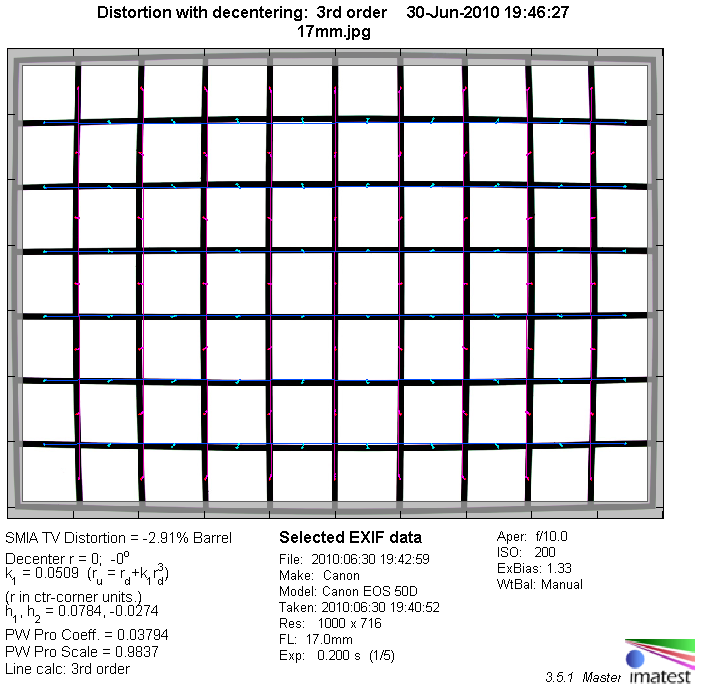|
Sigma AF 17-50mm f/2.8 EX DC HSM OS - Review / Test Report - Analysis |
|
Lens Reviews -
Canon EOS (APS-C)
|
|
Page 2 of 3

Distortion
The distortion figures of the Sigma 17-50mm EX OS are fairly typical for a fast standard zoom lens. At 17mm it shows very pronounced barrel distortion (~2.9%) and a slight pincushion distortion at longer focal lengths. The two opposing distortion types even out somewhere between 24mm and 35mm.
|
Move the mouse cursor over the focal length text marks below to observe the respective distortion
|
| 17mm |
24mm |
35mm |
50mm |

|
The chart above has a real-world size of about 120x80cm.
Vignetting
The amount of light falloff is, unsurprisingly, most pronounced at 17mm @ f/2.8. At around ~1.3EV (f-stops) the issue will be noticeable in some situations here. Stopping down to f/4 resolves most of the problem and it's not really field relevant anymore. The 24mm and 35mm setting show a more moderate characteristic here whereas the light falloff increases again to 0.9EV at 50mm @ f/2.8.

MTF (resolution)
The Sigma lens has a rather unusual but generally impressive resolution characteristic. The center performance is excellent straight from f/2.8 and it's nothing short of outstanding at f/4. The border performance is decent at f/2.8 but the extreme corners are, unfortunately, soft in the wide and mid portion of the zoom range. However, the quality almost explodes when stopping down to f/4. Both the border as well as the corners are boosted well into very good territory and sometimes beyond. The global peak performance is reached around f/5.6. Diffraction effects starts to have a slight impact from f/8 onwards. The amount of field curvature is minimal across the range.
The tested sample had a good centering quality.
Please note that the MTF results are not directly comparable across the different systems!
Below is a simplified summary of the formal findings. The chart shows line widths per picture height (LW/PH) which can be taken as a measure for sharpness.
If you want to know more about the MTF50 figures you may check out the corresponding Imatest Explanations
Chromatic Aberrations (CAs)
Lateral CAs (color shadows at harsh contrast transitions) are well controlled including the critical 17mm setting. The average CA width at the borders varies around the 1px mark with a slight peak of ~1.2px at 17mm f/4. This is noticeable at 100% image magnification on your screen but it's not really relevant anymore for prints.

Bokeh
The Sigma is a comparatively "fast" lens thanks to its max. aperture of f/2.8. However, the max. aperture appears somewhat
more attractive in terms of depth-of-field than it actually is. Compared to a similar full format setup it
"looses" about one stop in this respect (equivalent to f/4). Anyway, let's have a look at the bokeh quality at the 50mm setting now.
Standard zoom lenses tend to struggle regarding the quality of the out-of-focus blur. The Sigma is surely not perfect either but it does a comparatively good job. There's an outlining effect in out-of-focus highlights at f/2.8 and the inner highlight zone is slightly nervous but we've seen worse here. The quality of the back- and foreground blur is decent for such a lens. The bokeh deteriorates somewhat at wider focal lengths but that's a rather common behavior.

Bokeh Fringing / Longitudinal Chromatic Aberrations (LoCA)
Bokeh fringing at large apertures is a problem which is often not well corrected. However, the Sigma lens
has no significant issues here. The amount of green and purple halos in out-of-focus areas is already barely
noticeable at f/2.8 and basically negligible in field conditions.
|
Move the mouse cursor over the f-stop marks below to observe the respective LoCAs
|
| f/2.8 |
f/4 |
f/5.6 |
|

|
These sample portions were taken at 50mm.
|